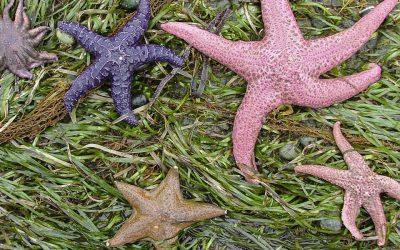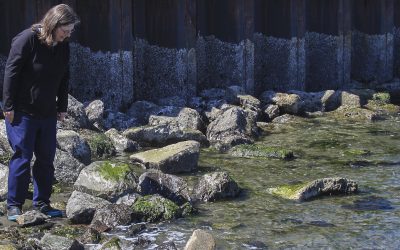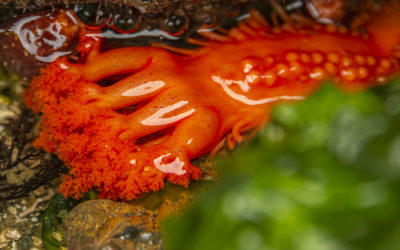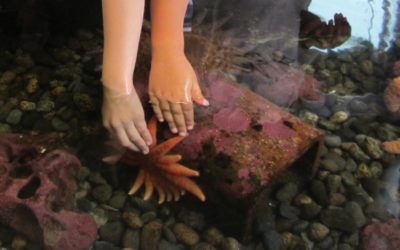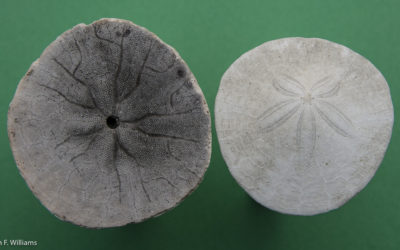Windows on the Sea
by Nancy Sefton
Photos & video by John F. Williams except where noted
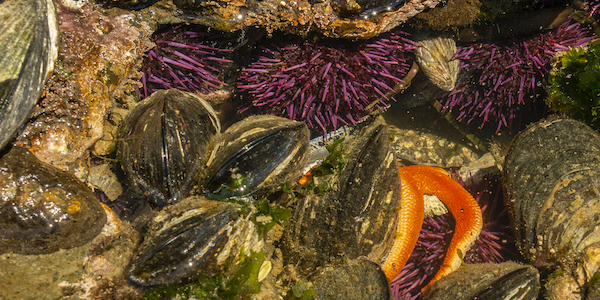
Windows on the Sea
By Nancy Sefton, Summer 2019
Photos & video by John F. Williams except where noted
I am bent over double, unable to stop a steady slide down a slope of green slime, tennies soaking, shoulders in knots. Add a sniffly nose, blue hands, and legs that collapse like a folding chair when I try to stand. Without warning, the sea sends an occasional scout wave to lick hungrily at my cold, wet feet. I’m in heaven.
When moon and sun pull back the sea twice every twenty-five hours, marine life representing a variety of biological groups, from crabs to seaweed, are showcased for the beach hiker. Colorful life decorates rocky walls, shallow pools, and narrow channels. Some creatures become dormant when exposed to air, their shells closed like trap doors. Others occupy shallow pools, carrying on their normal lifestyles, defending themselves, feeding, even reproducing while they await the sea’s return, a promise never broken.
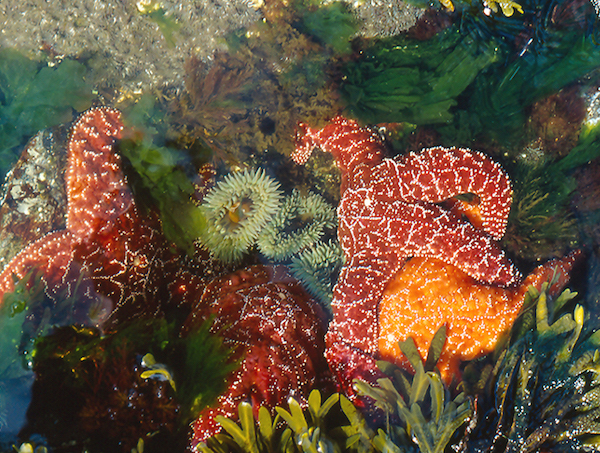
Photo by Nancy Sefton
The intertidal zone can be a tough neighborhood. Tidal pools are heated by the summer sun, and salinity increases as the water evaporates. Nevertheless, a variety of sea creatures seem unfazed by this inhospitable real estate. The exposed shore may percolate with life.
To fully appreciate nature’s clever adaptations, one must get close up and personal.
The magic is in the details: clinging feet, suction cups, gripping fibers, custom shell shapes, rubber necks, impregnable armor, a camel-like tolerance for the sun’s heat.
I sit quietly on the edge of a shallow pool strewn with small pebbles. Shortly the bottom begins to stir. Two-inch fish, aptly named tidepool sculpins, begin skittering here and there in zigzag trajectories, well camouflaged against the pebbles, invisible until they move.
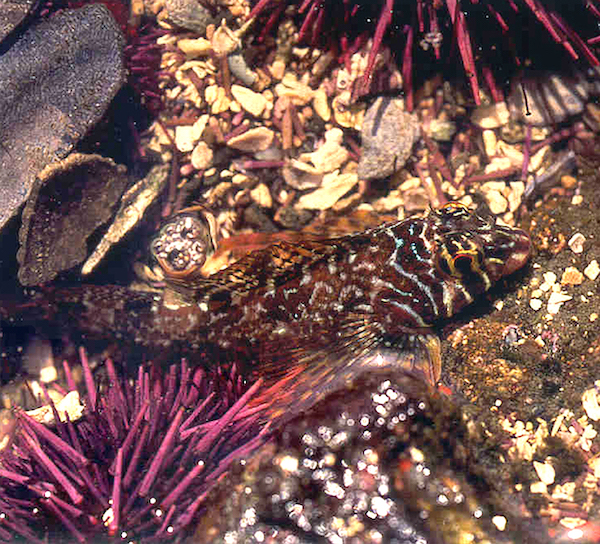
Tide pool creatures including sculpin. Photo by Nancy Sefton
See if you can spot the tidepool sculpins. It’s easier when viewing the video full-screen.
Nearby, some little black rocks sprout jointed legs and lurch across the bottom – hermit crabs, dragging their borrowed snail shells like RVs as they forage for food. But in the next pool, it’s a free-for-all. A pile of hermits frantically joust over an empty snail shell that’s larger than any of theirs. Hermits grow, but their confiscated armor doesn’t; so periodically the vulnerable hermits must trade up for a larger home.
 See more about hermit crabs & more video and photos in “Exploration of Salish Sea Tide Pools” in this issue.
See more about hermit crabs & more video and photos in “Exploration of Salish Sea Tide Pools” in this issue.
Usually, hermit crabs are hiding at low tide, but occasionally you might see ones like these.
Photo by Nancy Sefton
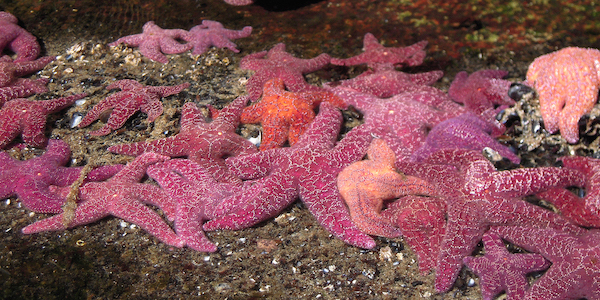
Photo by Nancy Sefton
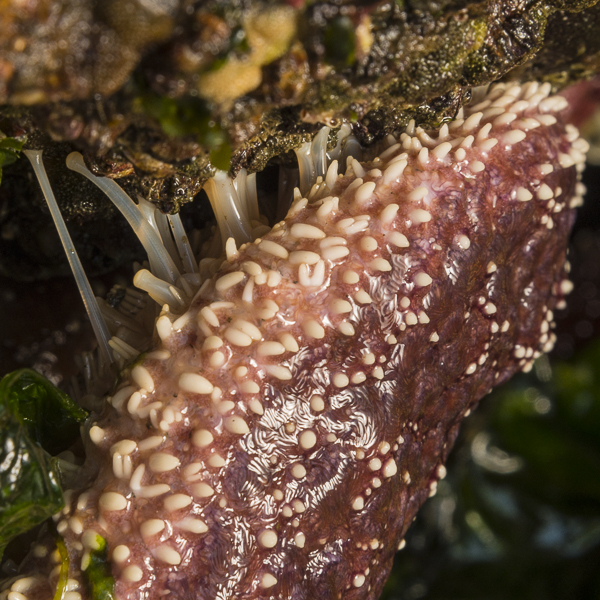
Sea star hanging from a rock by its tube feet.
All around me, sea stars grip the rocks. The Pacific’s colorful ochre star with its five stout arms, a voracious carnivore that creeps across the exposed shore, shamelessly gorges itself in mussel and barnacle beds.
Sea stars travel on thousands of tube feet lining the undersides of their arms. Besides allowing slow travel, the tube feet facilitate dining. When the star encounters a delectable shellfish, such as a mussel, it envelops its prey and the tube feet handily pry the two shells apart.
And here’s the obscene part: the star actually inserts its stomach between the shells to devour its victim’s interior soft parts. If you should see a star all humped up on a rock, you’ve caught it in the act!

Bat star photo by Nancy Sefton
Colorful bat stars, not quite so mobile, are scattered helter-skelter in stunning shades of red, orange, blue and purple on the bottoms of dark pools, cartoon stars in a painted sky.
It’s not uncommon to witness a sea gull with half of a rather large star drooping from its beak, it’s startled expression seeming to say “I can’t believe I’m eating the whole thing!”
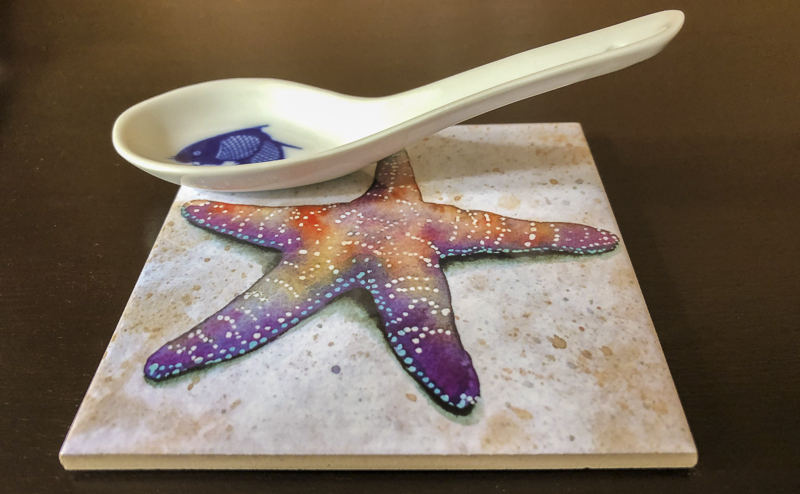
Sea Stars are a common motif in marine art, like this almost 3 dimensional looking star on a ceramic coaster by Mary Gibbs (http://marygibbsart.com).
Various kinds and sizes of anemones blossom like chrysanthemums, some open and inviting, others closed upon themselves. Seemingly created in a moment of whimsy, these flower look-alikes are carnivores, their poisonous tentacles spread to seduce the unwary. As I watch, a tiny blue crab accidentally wanders onto the central disk of an anemone, and oops, the outer ring of tentacles begins to close over it. Not a pretty sight, as the victim goes down into the anemone’s gullet, only one tiny claw emerging in a silent plea for help. In the same tide pool, a neighboring anemone is busy spitting out shell bits from a luckless crab it probably dined on yesterday.
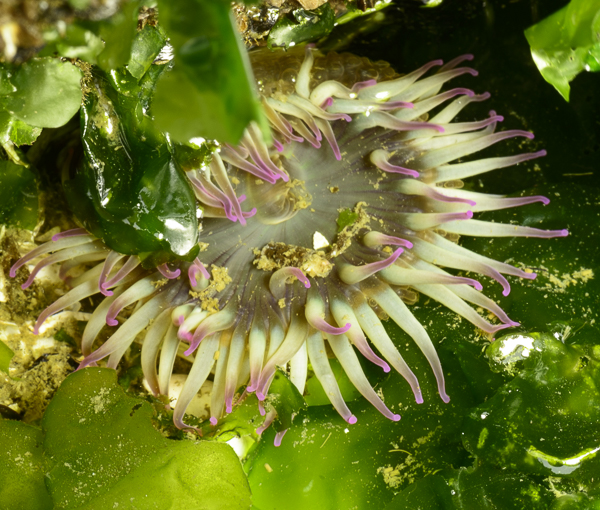
The anemone, a fairly stationary creature, has another trick up its tentacles. As I lightly brush one with my fingertip, I feel the characteristic sandpaper grab as myriad microscopic darts are fired into my skin, the anemone no doubt anticipating a grandiose lunch. While I can easily withdraw, a passing sculpin getting this close would be instantly paralyzed and sucked down (like that sorry crab) into the anemone’s central mouth.
 See more about anemones and their barbs in “Flower of the Tide Pool” in Issue #1.
See more about anemones and their barbs in “Flower of the Tide Pool” in Issue #1.

Photo by Nancy Sefton
I sit very still by a narrow surge channel, a crevice between rocks. From its dark depths, a red fluid form rises to the surface, extends tapered tentacles into the exposed yellow rockweed and probes for a meal. Unmindful of me, an octopus casually penetrates a forbidden world. I’m definitely on my way to “sea creature overload.”
At each tiny pool I’ve stared through the sea’s looking glass into a tantalizing world I can never be part of. The tide turns at last and water flows like a transfusion into nooks and channels, bringing renewal. But for me, curfew is near. As the sea inches forward, intertidal residents resume their normal lifestyles, while I, the uninvited, retreat to higher ground.

Nancy Sefton is an artist, writer, videographer, and photographer who specializes in nature subjects. A former diver, she has contributed frequently to national magazines and newspapers, publishing over 300 articles about marine life. Nancy now lives in Poulsbo and writes for Sound Publishing newspapers.
Table of Contents, Issue #4, Summer 2019
Star Eat Star World
by Paul Pegany Photos & video by John F. Williams except where notedSome of the variety of local sea stars. Photo by Sharon PeganySome of the variety of local sea stars. Photo by Sharon PeganyBy Paul Pegany, Summer 2019 Photos & video by John F. Williams...
Tide Pool Seaweed
by Sara Noland Photos & video by John F. Williams except where notedPhoto by Tom NolandIt's low tide on a lovely Pacific Northwest afternoon. The beach is an expanse of rippled mud and sand, with cobbles and scattered boulders near the water’s edge. I’ve forgotten...
Sea Cucumbers
by Paul Pegany Photos & video by John F. Williams, except where notedBy Paul Pegany, Summer 2019 Photos & video by John F. Williams except where notedSea cucumbers are elongated creatures with a mouth on one end and an anus on the other. They appear soft,...
Salish Sea Tide Pools
by Adrianne Lauman, Summer 2019 Photos & video by John F. Williams except where notedBy Adrianne Lauman, Summer 2019 Photos & video by John F. Williams except where notedA tide pool is created when a small amount of marine water is left on a shoreline or in...
Portals of Discovery
by Sharon Pegany Photos & video by John F. Williams except where notedImage courtesy of Feiro Marine Life CenterImage courtesy of Feiro Marine Life CenterBy Sharon Pegany, Summer 2019 Photos & video by John F. Williams except where notedAs spring gives way to...
Postscript 4
by John F. Williams Photos & video by John F. Williams except where notedBy John F. Williams, Summer 2019 Photos & video by John F. Williams except where notedThis issue marks a full year of publishing for Salish Magazine! I've learned a lot of lessons, and a...

